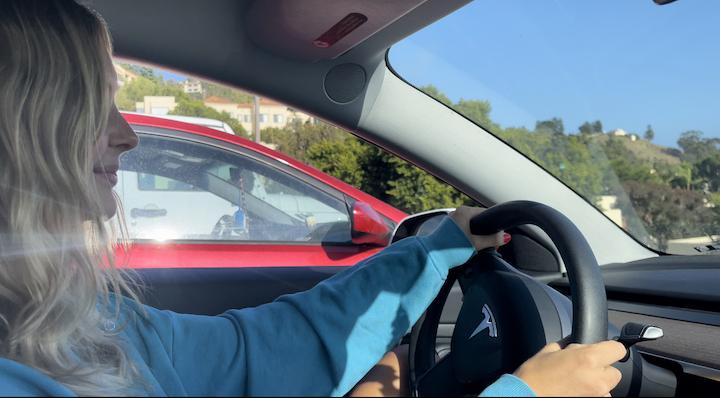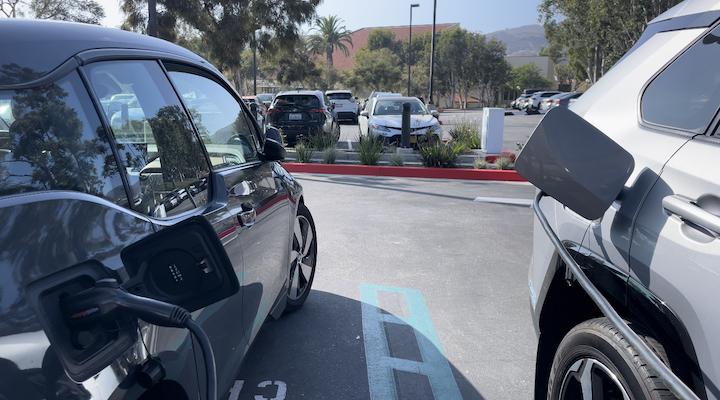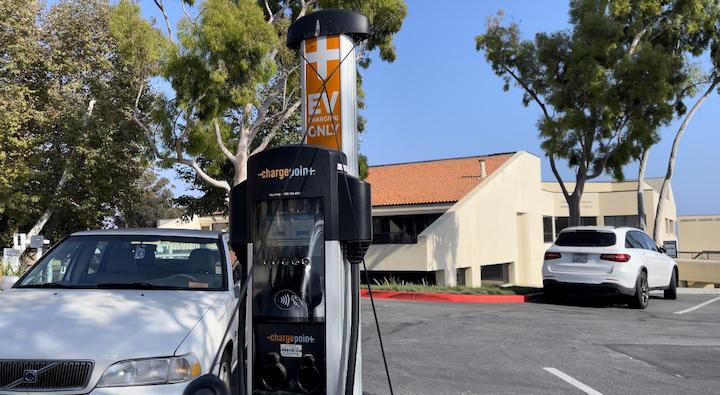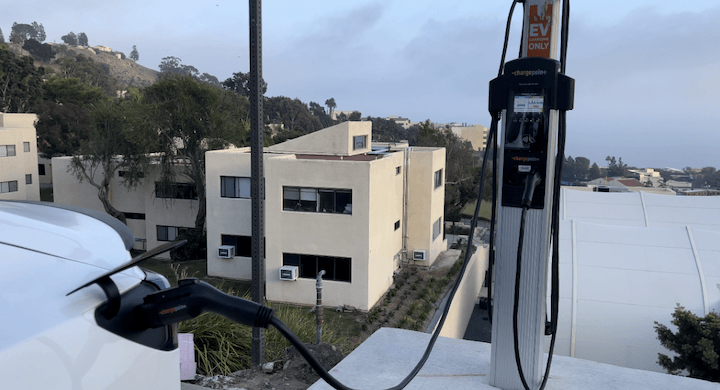
Sophomore Samantha Conant searches for an open charging spot on campus for her electric vehicle. With the limited electric vehicle spaces, Conant said she sometimes has to look off-campus. Photos by Louise Brickman
Over the next decade, the number of electric cars in the state of California will grow exponentially, according to Gov. Gavin Newsom’s website. The state banned the sale of gas-powered vehicles by 2035 on Sept. 23, with Executive Order N-79-20.
However, the state does not have the electrical infrastructure in place to power these chargers, according to the website of the California Electric Vehicle Infrastructure Project.
Pepperdine University has 16 charging spaces spread across the Malibu campus. However, the Pepperdine website says there are only 10. There are four on Main Campus lot, two in Rho parking lot and 10 in the Drescher lot. Out of 4,136 registered vehicles, 136 are electric, wrote Elyse Jankowski, associate director of Communications and Public Relations in an Oct. 5 email to the Graphic.
“More and more students are coming with electric cars and there just aren’t enough charging stations to go around,” said Chris Doran, Religion professor and founder and coordinator for the Sustainability major and minor. “You hear those complaints rather often.”
Pepperdine is following through on a master plan to build more parking structures and add 19 more charging stations, said Ben Veenendaal, associate vice president for Planning, Operations and Construction. However, the current electrical infrastructure cannot handle the power fast chargers require, Veenendaal said.
California’s Quest To Go Electric
The California Air Resources Board voted in August to ban all gas-powered vehicles by 2035 as they start to move the state away from oil and toward electric vehicles, Russ Mitchell wrote in an Aug. 25 LA Times article. Executive order N-79-20 said the board is to “act consistently with technological feasibility and cost-effectiveness.”
Gasoline and diesel-powered cars, sport utility vehicles, minivans and pickup trucks will be phased out with the zero-emission mandate, Mitchell wrote. Trucks burning diesel fuel have a similar proposed mandate to reach zero emission in 2045.
Air quality officials said the new regulations will reduce greenhouse gas emissions by more than 50% by 2040, Mitchell wrote. These gas emissions are the main driver of climate change, causing effects such as extreme weather, an increase in wildfires, polar ice loss, ocean warming and rising sea levels, according to NASA’s website on Global Climate Change.
In 2019, the leading source of carbon dioxide was tailpipe gas emissions — accounting for about 40% of the state’s overall greenhouse emissions, Mitchell wrote.
The plan will reduce smog from nitrogen oxides by more than 25% by the year 2037, Mitchell wrote. When burned, fossil fuels release particles of dirt and soot into the air, according to Generation 180, a nonprofit “working to inspire and equip people to take action on clean energy.”
Cars release carbon monoxide, which interferes with the blood’s ability to transport oxygen, and nitrogen oxide — an acidic and highly corrosive gas that affects people’s health and the environment, according to the New York Department of Environmental Conservation.
These particles get lodged deep in the lungs, causing asthma and other respiratory illnesses, according to the Environmental Protection Agency. Less smog would mean fewer deaths from heart disease and fewer emergency room visits for asthma.
“Electric cars in general are going to be really helpful in transitioning us away from a carbon-based economy and a carbon-based transportation system,” Doran said.
Transitioning to a mostly electric mobile transportation system, carbon emissions would decrease by 922 million tons, according to a Center for Biological Diversity article — a nonprofit environmental advocacy group.
This is the biggest change in the automotive industry since the transition from horse and buggy, Tony Briscoe said in a Sept. 26 LA Times video. This will mean fewer gas stations and more electric vehicle charging stations, Briscoe said.

A car charges in the main parking lot on the Malibu campus Oct. 5. There are 16 electric charging spots located across the Malibu campus.
The state received federal funding to add more electric charging stations, according to a California Energy Commission press release. The state said they are planning to add chargers mainly along interstates and highways in the press release.
California received an initial $56 million in funding to install more charging stations throughout the state, according to a Caltrans news release. The state is expected to receive $384 million for the program over five years, according to California’s Deployment Plan for the National Electric Vehicle Infrastructure Program.
California is also investing $10 billion over several years to accelerate the switch from gas-powered vehicles, according to a Jan. 26, 2020 press release from Gov. Gavin Newsom’s Office.
The press release also said in addition to improving the charging infrastructure, they will increase the affordability of electric vehicles by adding accessible chargers in low-income neighborhoods.
The Infrastructure Investment and Job Acts has funding for California to finish a more than 6,000-mile statewide charging network, according to the California Energy Commission press release. This will provide more than one million chargers by the year 2030.
President Joe Biden signed the Infrastructure Investment and Job Act into law in November 2021. Its goal is to create well-paying union jobs and help modernize roads, bridges, railroads, ports, airports and more, according to The House Committee on Transportation and Infrastructure.
“It would be nice to see Pepperdine on the front end of that rather than not, but we’ll see how that goes,” Doran said.
The Current Roadblocks
Pepperdine has been thinking of ways to keep up with the rest of the state and was aware of this ban prior to the law’s passing, Veenendaal said.
“[We] have already been thinking about it from a master-planning perspective and how we will incorporate that and respond to that from a university perspective,” Veenendaal said.
The main obstacle is the cost of the electrical infrastructure, not the actual chargers, Veenendaal said. This includes the electrical poles, cables and other necessary foundation components above and in the ground, which are necessary to ensure the chargers work safely.
Veenendaal said if there is not already a transformer near a proposed charger site, Pepperdine would need to dig underground to install one, which would necessitate redoing the pavement.
The University developed its electrical grid for the Malibu campus in 1973, Veenendaal said, and the grid cannot handle the amount of power needed for the required amount of chargers.
“We are constantly looking for those opportunities so that University doesn’t bear the full cost of adding electric vehicle charging stations,” Veenendaal said.
Doran said another roadblock is the University is hesitant to address climate change directly.

One of the two chargers available on the Main Campus parking lot Oct. 5.Four spaces can be used at a time when charging.
“It seems to me that we’re not doing our best job in saying that all the science is as accurate as it can be, and so we should be treating this deadly seriously,” Doran said in a special climate change edition of the Graphic. “There’s a missed opportunity considering our public-facing website [Center for Sustainability] doesn’t even talk about this issue.”
The Situation With Parking Right Now
With the current 16 spaces available, 10 of them being at the Drescher campus, students and faculty said they have found it inconvenient to find available charging stations. All said the University needed more charging options.
“The EV charging stations that they have in Rho parking lot don’t work a lot of the time, and the app is complicated to use,” said Conant, who owns a Tesla Model S.
Conant said she switched from gas powered to electric because she wanted to avoid buying gas. She often charges her car at the Tesla superchargers in the Malibu Country Mart.
This is easiest for Tesla owners, as other electric vehicles need an adapter to connect the car to the Tesla supercharger. Students in need of a charge in order to get where they need have had to find a quick solution, according to Tom Monoughney in an Inside EV’s article.
“[Charging off campus is] more convenient for me than having to schedule times on campus,” said Dylan Hagen, a senior who owns a Tesla Model 3 and regularly charges at the Malibu Country Mart.
Students said they are starting to notice the increase in how many students bring electric vehicles to campus.
“I definitely recommend they add more chargers, especially with the amount of electric cars I see whether Teslas, Priuses, etc., it would be nice to have more options for parking,” said Calvin Peterson, a first-year who owns a hybrid Toyota Prius.
Peterson said his parents chose the car for him because of California’s shift to electric.
“My parents could see the future of the car market shifting toward electric and wanted to be fuel efficient and economically friendly,” Peterson said.
Students and faculty said they are more motivated to switch from gas to electric.
“I chose electric because I commute,” said Sara Fernandez, associate director of Production Operations in the Communication Division. “Driving an electric vehicle means not having to go to a gas station, or having bi-monthly maintenance for oil changes. Also, for me, it means paying less money. I was paying more in gas monthly to drive to work and other places with my family than what my monthly payment is.”

The charging station located in Rho parking lot on the Malibu campus Oct. 5. A car is plugged in, using one of the two spaces available.
The Pepperdine website said they allow each user to charge their car free for up to four hours at a time.
“You’re allowed four hours free, and then it’s an exuberant amount afterward,” Fernandez said.
The University automatically charges $60 per hour after this allotted time of four hours is over, according to the Pepperdine website.
Students and faculty said it can be tricky for those in class to move their cars when their time is up, or even earlier if their car charges faster. Many like Fernandez are in the Center for Communication and Business building, which is not near any charging station. The stations are primarily located in Drescher or main campus.
Fernandez said adding chargers in the CCB parking lot would be her request.
How Pepperdine is Adapting
The University is building a new parking complex near the baseball field, Veenendaal said. The new enhanced parking and storage area will have 19 charging spaces, Veenendaal said. Some chargers will have two spaces for charging, and others only one, due to the layout of the parking complex.
The University also plans to break ground on the Mountain in 2024 — a new athletics and events complex that will include a new parking garage, according to past Graphic reporting.
“The Mountain will have 42 [electric charging stations] on day one in the 831 stall parking structure,” Veenendaal said. “It will have the infrastructure and the power and the electrical capacity available nearby, as well as pathways and conduits, to charge up to over 200 additional cars or spaces.”
https://www.thinglink.com/card/1639432300007522307
Doran thinks that adding more charging areas on campus is a start toward California’s ultimate goal.
“I think it would help us connect with the rest of Malibu and the rest of Southern California who is trying to transition to these electric vehicles,” Doran said.
___________________
Follow the Graphic on Twitter: @PeppGraphic
Contact Louise Brickman via email: louise.brickman@pepperdine.edu
